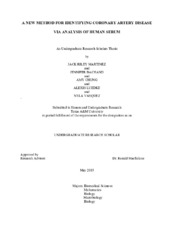| dc.description.abstract | Coronary artery disease (CAD), the number one cause of death in the United States, has traditionally been combated by reactionary diagnostics. However, the current healthcare dynamic is shifting towards a preventative approach, which aims to treat disease prior to the manifestation of symptoms. A minimally invasive diagnostic method which provides insight into an individual’s blood chemistry has the potential to facilitate this transition. This study analyzes the protein chemistry of human blood serum in order to differentiate between CAD and Non-CAD serum, with the goal of discovering potential CAD biomarkers. The Beckman/Coulter P/ACE MDQ Capillary Electrophoresis System was coupled with a commercial SDS-Gel based buffer system in order to achieve highly resolved serum protein spectrums. Electropherograms for nineteen participants were analyzed in 32 KaratTM Software by integrating protein peak areas, which were then normalized using an internal standard. Based on these integrations, a Linear Discriminant Analysis (LDA) algorithm was generated using OriginPro 8.6 Data Analysis and Graphing Software for the purpose of distinguishing between CAD and Non-CAD individuals. Cohorts of twelve CAD and seven Non-CAD participants were used for training purposes. This training data was classified with 100% accuracy, and an obtained p-value of 0.00332 indicated a significant difference between the CAD and Non-CAD participants’ peak distributions. This study establishes the utilization of capillary gel electrophoresis techniques for serum classification purposes, and ultimately points toward the development of a new, minimally invasive diagnostic tool for CAD based on blood protein chemistry rather than symptom onset. | en |


